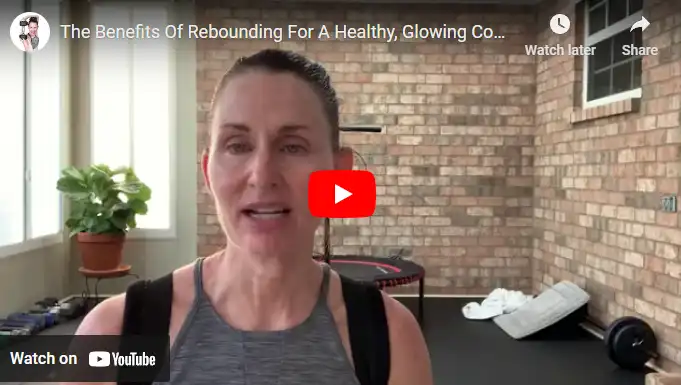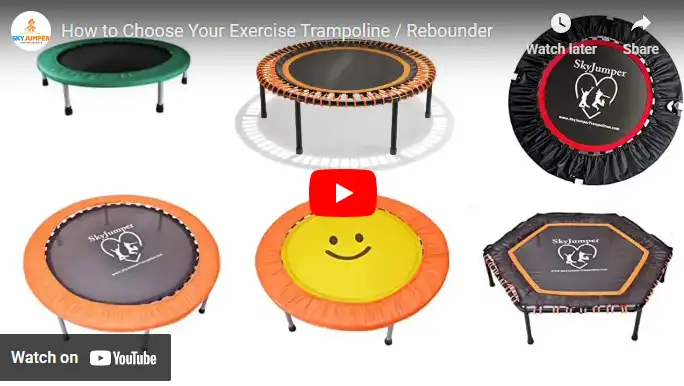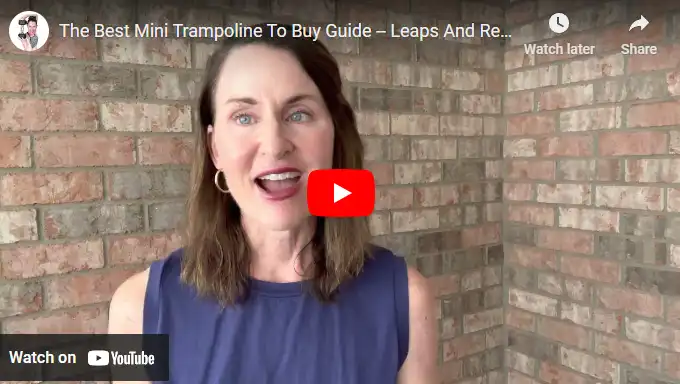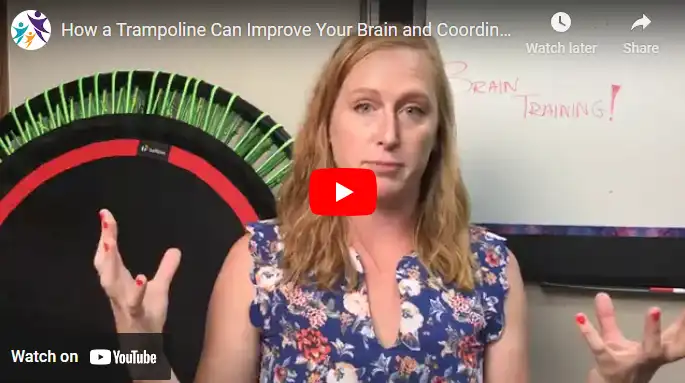Checklist: What to Look for When Buying a Rebounder?
Disclaimer: This website exists thanks to you, the readers. When you buy through links on my site, I may earn an affiliate commission.
Rebounding workouts have plenty of benefits — for adults, there is weight loss, overall health improvement, strengthening bones and joints, and for toddlers, the benefits of trampolines include developing vital motor skills and coordination. But what to look for when buying a rebounder?
There are several things you need to consider when choosing the best rebounder that meets your needs.
Examples of these are weight limitations, adjustable features, durability, ease of assembly, etc. It’s important not to be careless about the quality of the materials or the base and the assembly of the rebounder so that you can get the best out of your workout.
Also, it’s good to know the difference between a rebounder (also called a “mini-trampoline”) and a trampoline. Rebounders are designed for specific exercise routines (e.g. aerobics), while trampolines allow a wider range of workouts, such as flips, handsprings, and tumbling exercises.
Here are several tips on what to look for when buying a rebounder.
What to look for when buying a rebounder?
To choose the right rebounder for you, you have to watch out for several aspects. We have researched and compiled this guide to help you make the right choice of a rebounder that will serve you well, keep you safe, and of course, meet your budget.
1. Assembly
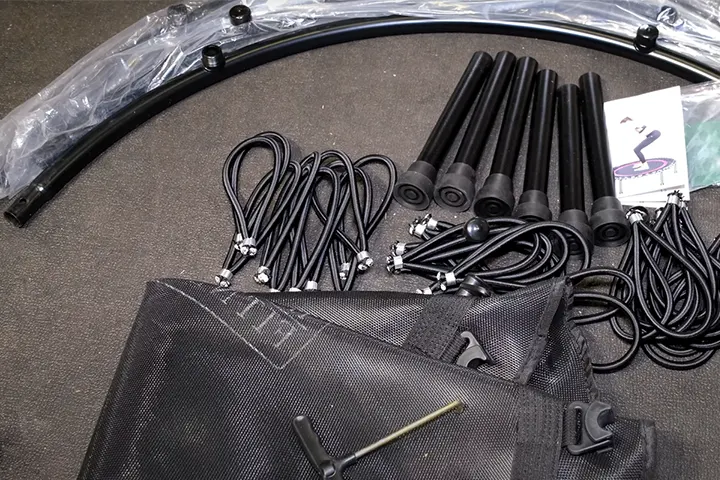
Many people might underestimate the importance of the assembly when buying a rebounder or a trampoline, while it’s actually key for the overall use of the device and the safety of the user.
The base keeps the whole equipment together and provides reliable support for your exercise. So, in order to avoid any incidents and to fully enjoy the fun of your rebounder workout, you should pay extra attention to the quality of the assembly.
When it comes to the material of the framework, the main options are two — steel and plastic.
Most rebounding experts say that steel units ensure better support and, so, are safer and more reliable than plastic ones.
Whichever you choose, don’t go for the units that have screw-in legs! The cons of these are that they provide less reliable overall support, they become loose when kept in storage and they tend to wear down over time.
Instead, we advise you to go for frameworks with snap-in legs.
2. Size
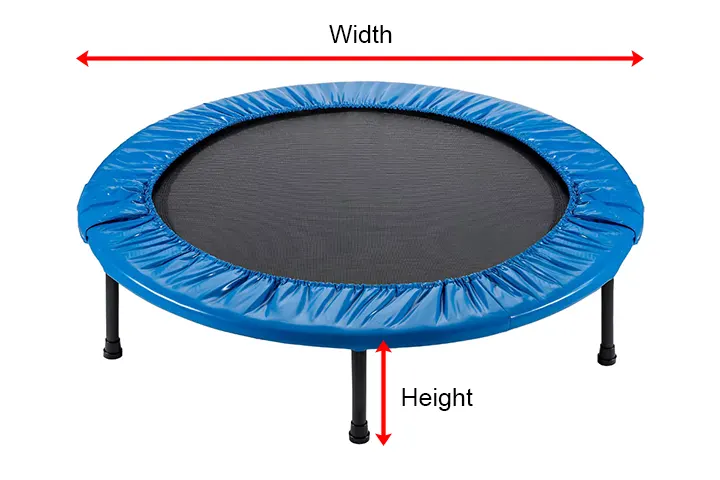
The next task is to answer the question, “What size rebounder I should get?”
The first thing to consider is, of course, the space you have available. If you have a wide free room at home, you might want to get a bigger size rebounder so you can fully enjoy your workout. If your space is limited, then it’s better to go for a small, foldable rebounder.
When talking about space limitations, it’s important to mention that you should make sure to have at least 10 square feet of free space to place your rebounder.
Secondly, the size of the rebounder also depends on your age, weight, and the type of exercise you want to practice. Generally speaking, the size of a rebounder should be at least 40 inches for an adult to be comfortable exercising. Larger is better and increases the number of exercises you can do. As the Bellicon site says:
“On the larger sizes, you can do ab workouts, pilates, yoga - you name it! Since the mat is a lot softer than solid ground, workouts like these will be easier on your back.”
Last but not least, it’s good to consider where the rebounder is going to be stored. The advantages of bigger and sturdier rebounders are that they are generally more long-lasting, safer, and allow a wider variety of exercises you can practice on them. But if you’re limited in terms of space, go for the foldable rebounders that you can easily put away.
3. Weight limit and stability
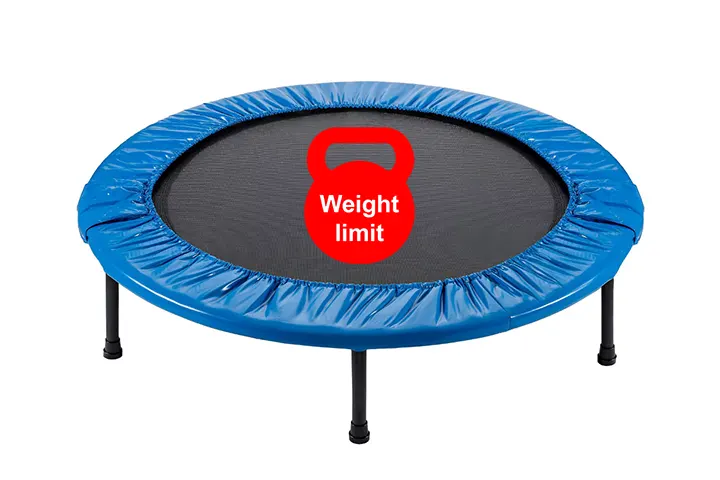
When it comes to what to look for when buying a rebounder, weight capacity and stability are crucial. This depends on the material of the springs and the frame, the elasticity of the cords (if there are any), the number of legs, and the quality of the mat.
The rebounder’s base is key for your safety because it is what keeps the entire equipment together and provides full support for the user. That’s why you should pay extra attention to the weight limits the particular device can take and the materials each part of it is made of.
When talking about rebounders, you need one constructed in a way that keeps the device stable and the bouncing smooth and enjoyable.
4. Springs
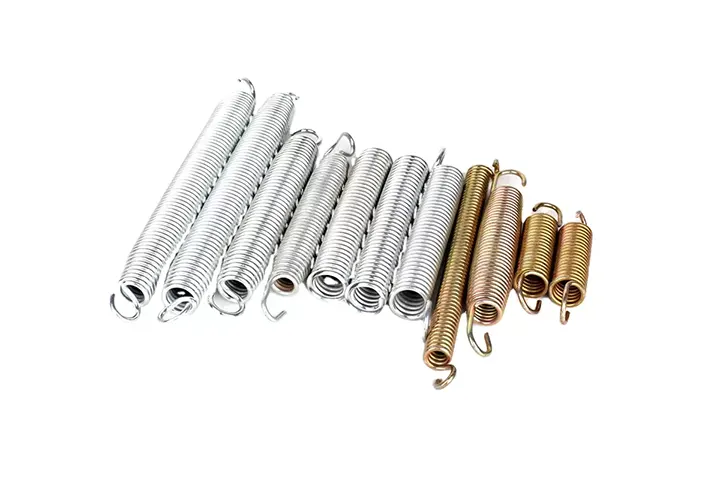
In terms of springs, the key factors for your choice of a rebounder are the support they provide for the whole base, and also the flexibility they offer to make your practice as efficient and enjoyable as possible.
Tube springs
You should consider the material your rebounder springs are made of according to your particular needs and preferences. Safety-wise, tube springs tend to be less reliable and are also limiting the movement and types of exercise one can practice.
Bungee cords
Another option for spring type is bungee cords. However, this type of rebounder is not a great choice if you want more intensity and jumping when rebounding. The cords tend to wear down over time and don’t provide enough support for the body which may lead to ankle injuries and ruin the fun of the workout.
So, keep in mind that you will have to replace that part of your trampoline with time.
Tapered steel springs
The third option is tapered steel springs. Rebounder reviews show that tapered-steel-springs rebounders are the best choice. In terms of durability, they show better results than tube springs and bungee cords. These rebounders also provide better flexibility, giving the opportunity for wider types of exercise. They also provide better support, catering to bigger body weight ranges and large movements.
No springs
Yes! This is also an option. There are also spring-free rebounders on the market. These are good for people who suffer from bad knees or different joint issues. Besides the health benefits of this type of mini trampoline, the spring-free structure also ensures quieter bouncing, so some users consider them the best at-home rebounders.
5. Mat
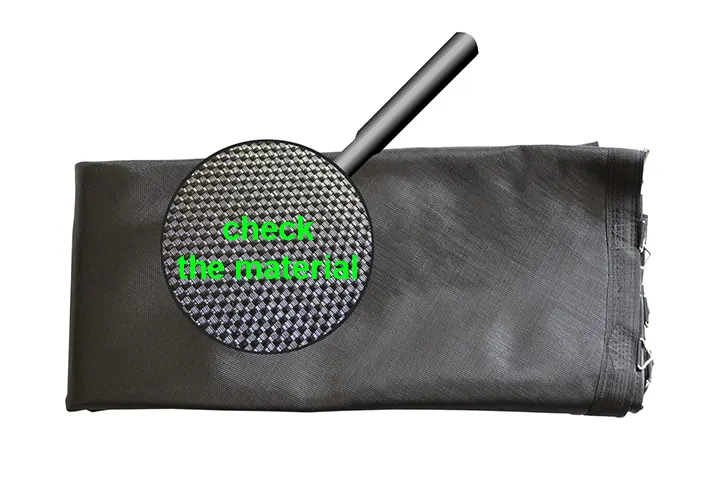
When it comes to what to look for when buying a rebounder, checking the mat is very important. Focus on its size depending on the specific exercise you want to practice. Also, check the material it's made of and the way it’s connected to the springs of the device.
Since the mat is that visible part of the trampoline you will be in direct contact with, it’s good to consider the above factors before purchasing. The bigger the size of the surface, the wider the variety of workouts you can enjoy on your rebounder. However, this also depends on the space you have available.
Most mat surfaces consist of woven fibers that are made of polyethylene and nylon fiber strands. If the mat material is thick enough, then the mat surface is strong, but also soft and supportive. Other types of mat materials are nylon, plastic, or canvas, but these aren’t strongly recommended, since they tend to stretch over time and directly affect the support of the rebounder.
6. Safety pads
Protection pads are crucial for a comfortable and safe workout. They cover the springs and screws surrounding the trampoline and the spaces between them. Even a single wrong bounce can lead to the user landing on the springs and screws and causing injuries. So, it’s important not to neglect that part of the equipment when choosing the right rebounder for you. Some trampolines even have UV-resistant pads, which makes them perfect if you want to use them outdoors.
7. Supportive handlebars
A supportive handlebar is an arch-shaped, adjustable piece of equipment that sometimes comes with the trampoline. It supports you while bouncing so you can feel more stable and safer. It’s good to get that handlebar if you’re new to bouncing workouts.
Still, some specialists advise not to get used to it too much, as it may cause bad posture. The best thing to do is to slowly move away from using the handlebar. However, in terms of safety, it’s helpful to get one before starting to practice rebounding workouts.
8. Number of legs
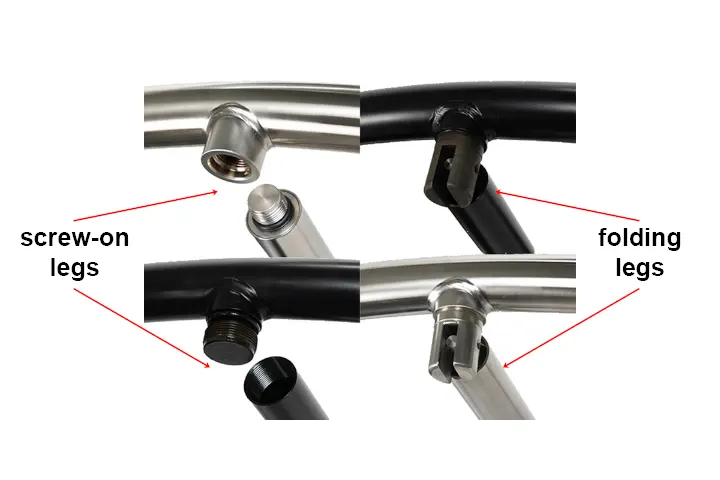
The stability and support of your rebounder depend on the number of legs it has — the more legs, the more stable it is. Based on shape and size, the most popular rebounders on the market have either 4 or 6 legs.
Choosing a 6-legged rebounder assures more stability, but you should also look at how the rebounder’s legs are aligned. They should be attached to the outside edge of the frame and their lower part needs to remain straight to the rails. That’s how you know it's correctly adjusted and safe enough to be used.
You can typically choose between a rebounder trampoline with foldable or screw-in legs. You can also get a device that is fully foldable or at least has foldable legs.
Should you choose a foldable rebounder?
If you’re not planning to travel with your equipment often, and you keep it in one place, then it’s best to get a rebounder with screw-in legs. But keep in mind that rebounders with screw-in legs tend to wear down over time, risking the stability of the whole device becoming looser. That’s why many most people prefer snap-in legs.
9. Portability
The benefits of a portable trampoline are mostly that, if you’re going to use it at home and your space is limited, you won’t have to create a special room to keep it in. You can easily move the rebounder to any room you want and then just put it under your bed until you want to use it again.
Some trampolines offer limited portability, meaning you can only fold the legs while others allow you to fold the trampoline, so you can easily transport it if you need to. Some rebounders on the market even come with carrying cases, which makes it even easier to carry and transport them.
10. Replaceable parts
It’s important to invest in a rebounder with parts that can be replaced. Even if it’s a high-quality product, some factors like sunlight or heavy usage can still damage it.
Make sure the particular parts of your rebounder can be found on the market if you have to replace any of them. The tricky thing here is that some of these parts can either be found with much struggle or they might cost more than it makes sense to pay.
Being able to buy spare parts will also save you money because you won’t need to buy a new rebounder.
11. Price
When talking about the price, there are a lot of things to consider. First is safety — to make sure the rebounder won’t cause you any injuries, it’s worth investing in a high-quality brand.
Cheaper rebounders usually aren’t reliable in terms of the quality of the materials they’re made of and the amount of time their parts are going to last. In other words, if you find a rebounder costing less than $250, then it’s most probably an unreliable one.
Another factor is what your goals are. For beginners, a small rebounder trampoline might be a good option. It also comes with a smaller price tag.
More experienced users might look for a lot more factors when buying a rebounder — its foldability, the thickness of the mat, the material and number of its legs, the product’s warranty and customer support, etc.
When you decide where you’re going to use it, how often, and what your space limitations and personal specifications are. That’s when you will know the average price of a trampoline that fits all your needs.
12. Quality
The key aspects of a rebounder’s quality are its longevity, repairability, and the quality of the materials it’s made of. So, to make sure you can experience the whole fun of bouncing and not worry about safety, our advice is to always go for quality over cost.
Customer rebounder reviews, quality standards, and seals of approval might help you in finding a good-quality rebounder or a trampoline. It’s better to take the time to choose the best quality option for you that is going to be long-lasting, fits your needs, keeps you safe, and gives you all the fun of exercising, rather than just picking a random rebounder and regretting it later on.
13. Comfort Level
Your comfort when doing a rebounder workout depends on a few factors. First of all, the bounce level of the mat (see next point!). High-quality rebounders are made of more reliable materials. This ensures a smooth experience when you exercise and helps you get the most for your health and body shape.
Another aspect of your comfort is your safety. That’s why it’s important to choose the right mat. It’s directly attached to the springs and the frame to prevent injuries. If you feel more comfortable practicing barefoot or with socks and not wearing shoes, then pay attention to the mat’s producing material.
14. Bounce Level
This depends on your level of experience. Beginners usually prefer gentler bouncing, where their feet don’t actually move away from the rebounder. Advanced users may prefer more energetic, high-jumping exercises. But a higher bounce level doesn’t necessarily mean the rebounder is high-quality. This is just one aspect.
A good rebounder will provide smooth, quiet, and safe bouncing because of its structure and the materials it is made of. The shape of the equipment is also important for the bounce level. Let’s compare them.
Shape | Bounce Level |
|---|---|
Round | If you buy a round rebounder, the more you get away from the center of the mat, the less bouncing you will feel. That’s because of its centered gravitational pull. This type of rebounder is a good option for beginners. |
Rectangular | Rectangular or square trampolines are better if you want higher bouncing. |
Oval-shaped | Oval-shaped trampolines are gaining popularity recently. They don’t have a centered pull of gravity, so you will get equally high bouncing in the middle of the rebounder or in its edges. |
Your goals are also a factor when thinking of a rebounder’s bouncing level because it might directly affect the type of exercise you can practice on it.
15. Warranty And After-sell Services
It’s good to learn about your rebounder’s warranty beforehand. This is a very important item on the list "what to look for when buying a rebounder". Find out if there are any after-sale services that the merchant provides, especially if you’ve decided to invest more money into your purchase.
Depending on the warranty policy, different manufacturers provide different warranties. Usually, the longest warranty is on the frame, and if it’s a high-quality brand, that warranty would go around 5 years at least. Some manufacturers provide warranty on other parts of the rebounder as well, but it may vary in terms of which ones exactly and the amount of time covered.
Spring vs. Bungee Rebounder
There are pros and cons of both spring-based and bungee rebounders. It’s a matter of individual preferences to choose which one would be the better option for you.
Spring rebounders
Spring rebounders are durable. There are more suitable for people who love intense jumping and rebounding. These rebounders provide much support and stability, due to the firm bouncing. That makes them better and safer for beginners. Another pro of them is that they are more affordable and more long-lasting at the same time.
However, they are also noisier or can be set too tight, which might ruin your workout or even cause an injury. Also, it’s not a great idea to choose those if you have knee or joint problems due to the intense exercise they provide.
Pros
Cons
Bungee rebounders
On the other hand of the bungee vs. spring rebounder debate are rebounders with bungee-based mats. They are generally gentler and much quieter. Bungee rebounders are usually considered the best rebounders for lymphatic drainage. However, there are exceptions. For example, the Cellerciser® is a spring trampoline but it is actually very soft on your joints because it was built for lymphatic drainage.
The gentler bounce of these rebounders provides longer workouts and also allows you to train safely even without shoes.
However, again usually, they don’t provide as much support as the spring ones. Another common issue of bungee rebounders is the lack of elasticity, which leads them to snap over time, so in terms of durability, spring ones are definitely better.
Pros
Cons
How to Choose the Right Type of Rebounder: Tips
There is a huge variety of products on the market nowadays and it might be really confusing to make a purchase and be sure you made the right choice. That’s why we gathered the main tips that can help you get the rebounder that’s going to meet all your personal needs.
Choose quality over cost
Buying a rebounder is an investment not only in terms of your finances but also in your well-being and your overall health. That’s why you should consider all requirements and make sure you get a reliable high-quality rebounder that will last long and meet your needs. It should be produced out of good materials so it can be durable and safe for you, especially if you’re a beginner. Also, it would be great if it has a warranty on some or all its parts. You should also consider its additional features, such as foldability, the accessories it has, the color of your rebounder, its shape, etc.
Consider your training goals
Your workout goals and training level also take part in choosing the right rebounder for you. For example, we mentioned above that the best rebounders for lymphatic drainage are bungee (string-based) rebounders. If you want to burn some major amount of calories and take things to the next level, then maybe you need a bungee rebounder. You should decide what kind of workout you want to practice — different rebounders allow different varieties of exercise, different intensities of bouncing, and so on. It’s also important to make sure the rebounder will keep you safe if you have any joint, knee, or other types of problems.
Choose the right trampoline shape
There are a variety of rebounders shapes available on the market today. The choice of shape depends on several aspects. First of all, how much space you have - round rebounders are good for smaller rooms, whereas if you have a backyard, you can go for a rectangular or oval one.
The shape also affects the type of bouncing. The bounce on a round rebounder is more intense in the center than it is closer to the strings. It's great for beginners! Other types of rebounders allow an equal bounce all around the surface of the mat as well as more intense bouncing.
Videos To Help You Choose The Right Rebounder
How to choose the right rebounder for you
Selecting the appropriate rebounder is crucial for long-term use, ensuring it's safe, comfortable, and provides good value. When purchasing your first rebounder, consider several factors, including size, assembly, portability, and the materials used. If you're looking for a quick recommendation, I've extensively researched the options available and have listed my top three picks below.
Product | My Rating | Verdict | Price |
|---|---|---|---|
This rebounder innovative spring technology provides a unique and adaptable rebounding experience that enhances full-body strength. | |||
This compact mini trampoline stands out as a quiet, stable, and space-efficient option, delivering excellent value for its cost. | |||
This rebounder is a smart purchase for those seeking a durable, quiet, and safe option for consistent workouts, priced fairly for its features. |
FAQ
What type of rebounder is best?
Choosing the best rebounder is never easy with so many options on the market. Each device comes with different features and purposes, so you should know what your goals are. Buying a rebounder means investing in your health and that’s why it’s important to find a device that is long-lasting, is going to keep you safe, and will allow you to take the most out of your workout routine. Before purchasing a rebounder, you should look at its durability, ease of assembly, adjustable features, warranty, and quality.
When speaking of individual needs, you should consider the rebounder’s weight limitations, size and foldability, bouncing intensity, and resistance on your joints and knees.
Generally speaking, bungee rebounders are usually better for people with knee and joint problems who want a relatively easy workout. Spring rebounders are better for people who want an intensive workout to burn lots of calories.
What size rebounder should I buy?
The size of the rebounder depends on a few things.
First of all, weight limitations. Some rebounders are better for beginners, some are built for more intensive bouncing, which is what more advanced users are looking for.
Next, you should consider the space you have available. You can buy foldable rebounders, which are easy to store. There are bigger sizes, in case you have a backyard or a wider room.
Should you wear shoes on a rebounder?
A frequently asked question is, “Should you wear shoes on a rebounder?”
Yes, you can wear shoes on your rebounder. If you decide to do that, make sure you’ve put on good sports shoes. This will give you comfort and prevent injuries.
However, you can also do your workout barefoot or with trampoline socks on. This will engage more parts of your legs in the workout and the feeling and effect will be more intense after. People with supination or pronation of the feet, though, should not exercise without shoes for safety reasons.
What shoes/socks should I wear on a trampoline or rebounder?
Wearing shoes or socks while rebounding depends mostly on your current health condition. Some rebounders are safe enough to be used barefoot, which engages your ankles, feet, and lower legs in general. This gives you better results of your workout.
However, people who have supination or pronation issues are not advised to use rebounders without shoes on. Also, it’s better to use shoes during your workout if you’re a beginner and you need more support and stability. This is also a factor to consider when choosing the shape of your device because it affects the intensity and the focus on rebounding, e.g. round rebounders give you a more intense bounce around the center of the mat than rectangular ones. This is due to their structure, which is focused on the center of gravity pull.
How often should you rebound?
There is no certain frequency or amount of time you should rebound and this really depends on your goals and your fitness level. However, studies show that you can get many benefits with a little bit of rebounding workouts, which help you in your other sports activities.
What you should look for is choosing a rebounder that fits your individual needs, so you can get the most benefits out of your exercise routine and feel the joy of this awesome activity. Still, if you’re a beginner, you might want to start with shorter and slower sessions and build them up with time.
Who should not use a trampoline or rebounder?
If you have some permanent physical problems or you’ve suffered some injury recently, it’s good to make sure you feel good enough before you start your rebounding workout. These exercises affect most of your body and muscles and that’s why you should be aware of what your shortcomings are in order to stay safe. That advice is mostly for the people who suffer knee, ankle, or lower leg injuries because while bouncing you are affecting these parts of your body the most.
Where can you buy the best rebounders?
There are many retailers who offer rebounders, for example, Amazon (affiliate link). I often use that because it's an option is to order online. You can return it if you decide to and you won’t have to travel to buy it. You can check my list of the best rebounders on the market for more info and a full comparison.
Conclusion
Since rebounding is becoming a trend and the proof of its health benefits is getting more attention, it's worth spending the time to actually get to know how to choose the rebounder that is most suitable for you. With the help of this guide, you will know the main features of different rebounders and most of your personal needs and preferences so you can choose the right rebounder for you. After that, all you have to do is to get all the fun and benefits of rebounding and enjoy your workouts!

